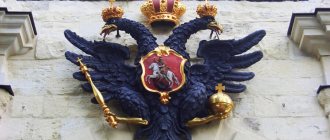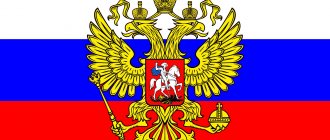The history of the Russian flag goes back several centuries. Over the centuries, the banner has been modified, but has not ceased to fulfill its most important functions - to serve as an identification mark, as well as to represent and symbolize the country and nation as a whole. Every citizen should know what the Russian flag looked like before and what it represents today, what it represents and what meaning it carries.
Flag and banner are two terms denoting the most important symbol of any state
In the Russian language, two words have long been used that have a similar semantic meaning: “banner” and “flag”. The first has Slavic roots and comes from the word “sign” or “sign”. It points to its owner and acts as a special symbol. The second term “flag” came to us from Holland and translated means “ship and seaworthy banner.” It was usually raised on a special mast called a “flagpole.”
Since ancient times, the flag looked like a piece of fabric of a certain geometric shape, which was attached to a cord or pole. It could have different colors, and often its colors carried a special meaning. It is difficult to overestimate the role of the banner in ancient land, sea battles and medieval battles, when it was used to control military detachments. To this day, it is used as a symbol of the state, power, as a “representative” of the nation.
All countries of the world have their own special single-color or multi-colored banner. The modern flag of the Russian Federation is easily recognizable - it is a rectangular panel with three horizontal stripes of white (top), blue (middle) and red (bottom) colors. For about three centuries, the Russian people “passed” under the tricolor. What did the Russian flag look like before? What did he symbolize? Let's try to figure this out.
Fairy tale or truth?
Turning to the past, to those times to which many flags of old European states go back, we regret to admit that Ancient Rus' was not affected by the Western European art of heraldry.
We know nothing about the use of coats of arms by Russian princes, there is no data under what banners the Russian regiments went into battle, and no armorial books of noble families have been preserved. Therefore, any appeals to antiquity belong more to the category of fairy tales than truth. It would seem that we have a huge historical source - many ancient miniatures in illustrated handwritten books. But the researcher’s work will be in vain. As the largest historian who studied medieval symbolism, Nadezhda Soboleva, writes about the images on miniatures: “The banners of the Russians and their enemies - the Polovtsy, the Pechenegs - are the same.”
The banners were drawn as needed, and the authors of the miniatures chose their color based more on the general gamut of the illustration than in an attempt to accurately convey the real princely banner.
Banners of the ancient Slavs
Historians know little about the ancient banners of the Slavic peoples. Presumably, the first of them were primitive and consisted of grass or horse tails, which were attached to poles, spear points or simply long sticks. It is believed that they were similar to the horsetails of the Turkic tribes. The Tale of Bygone Years mentioned banners that designated military units - banners (cloths attached to a pole). Gradually, a special position appeared - the flagman: he had to keep the banner and unfurl it during the battle. Over time, banners not only began to serve as landmarks in battle, but also transformed into special symbols of power. The princes, capturing cities, began to hoist their banners over them, announcing their claims.
Banners of the Old Russian State
In Rus' in the 9th-13th centuries. Banners of an elongated triangular shape, ensigns with a beveled wedge and border, as well as banners with braids sewn to them, fluttering in the wind, were common. Banners were often used in battles - special sacred banners on which the faces of saints, the Mother of God or the Savior were depicted. Ancient banners were made from different fabrics and painted in different colors. The most frequently used shades were green, red, blue, white and cyan. On the Kulikovo field, a large red banner stretched over the Russian soldiers, on which the Savior Not Made by Hands was depicted.
Royal banners during the period of the 16th-17th centuries.
Until the 18th century, Russia did not have a single state banner. There were a large number of different banners and banners. The Small and Large royal banners were particularly bright and beautiful. As a rule, they were richly decorated and decorated with religious themes.
An example of such banners is the famous “Great Banner” of Tsar Ivan the Terrible. It was a huge multi-colored trapezoidal panel. It was decorated with images of St. Michael sitting on a golden winged horse and Jesus Christ in glory. Also on the canvas were skillfully painted golden cherubs, seraphim and angels in white robes. This greatest banner accompanied the Russian army in battles and campaigns for more than 150 years: it visited the Crimean (1687, 1689) and Azov (1696) campaigns, as well as in the war with the Swedes. The photo of the flag of Tsarist Russia, unfortunately, does not convey all its beauty and power.
Such royal banners were given special honors: they were illuminated, along with icons, and they were worshiped. Regimental and centurion banners were smaller in size and not as richly decorated as the royal ones. Often, instead of the faces of saints, a simple cross was depicted on them. Since the 17th century Secular emblems began to be applied to banners in the Western style, for example, drawings of a snake, eagle, lion, etc.
Banner of the “Most Merciful Savior”
The banner of the “Most Gracious Savior” also has its own history - under this banner the assault on Kazan took place during the time of the last ruler from the Rurik dynasty, Ivan the Terrible. Later, during the reign of Queen Sophia, troops went on Crimean campaigns under this banner. A little later, during the reign of Peter I, this banner united soldiers in the campaign against Azov and in the Swedish war, which became known as the Northern War.
What the Russian flag looked like under Peter the Great
During the reign of Alexei Mikhailovich, the first mentions of a unified Russian flag appeared. The Emperor, having studied the banners of other countries, chose three main colors for his - white, blue and red. In 1686, a new flag of Tsarist Russia was raised on the first merchant ship "Eagle". According to some versions, it had a rectangular shape. It featured a blue cross, the top left and bottom right corners were painted white, and the other two were painted red. Peter I, continuing the work of his father, modified the flag, defining the order of horizontal stripes on it. A photo of the flag of Tsarist Russia is presented below - it was similar to the modern tricolor, but had a double-headed eagle in the center.
Peter the Great also created a flag for the merchant fleet. It was a white cloth with a black double-headed eagle, with an orb and a golden scepter in its paws. Since 1705, the trade flag of Russia was officially approved - the tricolor, which was used on military ships until 1712, until a single stern St. Andrew's flag was approved - a white cloth with a blue cross diagonally. After this, the tricolor began to be used only on commercial ships.
History of the imperial flag of Russia. The royal banner in the 18th-19th centuries.
Subsequently, the Russian flag underwent significant changes. In 1742, a new banner was made in connection with the upcoming coronation of Elizabeth I. What did the Russian flag look like now? The yellow canvas depicted a black double-headed eagle, which was surrounded by oval shields with coats of arms.
Under Alexander I, black, white and yellow gradually began to be perceived as state colors. The banners of Russian regiments depicted a black double-headed eagle on a golden background. In 1858, a new coat of arms was developed, as well as the flag of the Russian Empire. Alexander II approved the imperial flag of Russia from three stripes - black on top, yellow in the center and white on the bottom. The photo shows what the banner looked like in the 19th century.
Unfortunately, the new type of flag did not appeal to the common people, but was perceived as purely official. In addition, the new banner was very similar to the German one. For this reason, Alexander III, a famous Russophile, returned the white-blue-red tricolor to the pedestal. In 1914, after widespread celebration of the 300th anniversary of the Romanov dynasty on the Russian throne, a symbiosis of banners appeared. The white, blue and red flag was complemented by a black and yellow imperial standard, which was depicted in the upper corner of the flagpole. This banner existed until the 1917 revolution.
Cossack standards
Since 1900, the Cossacks received standards that resembled cavalry standards in the regular army - on black shafts. On the front side there was an image of the Savior Not Made by Hands. On the back you could see the monogram of Nicholas II.
To buy a Russian flag, fill out an application using the phone number. We also accept orders for the production of historical banners by email
| (0) |
Flags and banners of the RSFSR and the USSR. Complex 20th century
The Russian and February revolutions took place under bright scarlet banners. Not only they, but all mass symbols were red. The October Revolution of 1917 also took place under the scarlet flag. On July 10 of the same year, the final version of the new banner was adopted.
The flag of the RSFSR was a red banner. In the upper left corner, near the shaft, there was a gold inscription - “RSFSR”. Since 1918, the use of the imperial tricolor was strictly prohibited. A scarlet banner was hoisted over the Kremlin.
In 1924, the Constitution of the USSR approved a new flag. The scarlet cloth now depicted a golden sickle and hammer, above which was placed a five-pointed star with a golden border. In World War II, the Soviet banner became a great symbol of the victory of the Russian people over fascism.
Grenadier regiments
The Grenadier regiments received this banner on June 29, 1910 in honor of the 200th anniversary. The cloth had a white border and was decorated with gold embroidery. The inscription on the St. George ribbon told about the military merits of the army:
- about the capture of 2 banners from the French during the battles of Heilsberg on May 29;
- about the victory at Friedland 06/02/1807;
- about the capture of Kars on November 6, 1877.
There was also an inscription on St. Andrew's ribbon, which was located on the reverse side of the banner. The anniversary years were indicated on it: “1710-1910”.
Return of the famous Russian tricolor
After a break of more than seventy years, the Russian tricolor was raised in the capital, above the building of the Supreme Council. This significant event took place during the days of the August 1991 coup. Now the flag of the Russian Federation is raised not only on government buildings in our country, but also on diplomatic missions abroad.
In addition to the tricolor, the St. Andrew's flag is still used to this day, as well as the Victory Banner, which was established by presidential decree in 1996. It symbolizes the heroism and great courage of the Russian people shown during the days of the Great Patriotic War. We hope our article was useful, and now you know what flags were in Russia. Any citizen should know the great historical past of his people!











